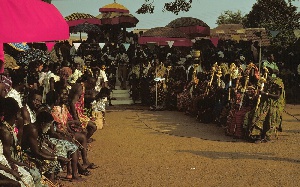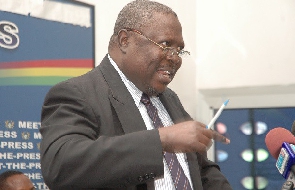In the year 1732, when the Ashanti Kingdom was ruled by Otumfuo Opoku Ware I, the Ashantis, mainly from Kuntenase, in an attempt to expand the kingdom, moved towards a place that is now part of the Volta region and to a place called Worawora.
They fought the Chokosis and drove them out from their land in 1734 and occupied it. They spoke their Twi language and maintained their culture and traditions. From then on many Akans from many Akan-speaking areas moved in to settle at different places including Jasikan, Donkorkrom and Avetime.
Something interesting happened which led to the creation and popularization of the compound word, “Tsoo-boi”. Many people and groups have used this compound word, “Tsoo-boi” without knowing how the word came about, and from which language it originates. Eighty percent of the people I interviewed said “Tsoo-boi” is a Ga word. Only twenty percent said it was an Ewe word.
“Tsoo-boi” is a word largely used in Ghana by many people including students, workers, demonstrators, pastors and Imams. When that word is mentioned, the resultant reaction is the same. It is a shout for action, attention and coordination. Furthermore the shout of “Tsoo-boi” creates a sense of belongingness, oneness, enthusiasm and victory.
In a fishing community in the Volta region, lived two fishermen and their families. They were not on talking terms. One family was Ewe and the other was Akan. The children of both families always had to cross a stream in a canoe to go to school.
One day, on their return from school, a strong wind blew the canoe to overturn in the full glare of by-standers. In an effort to get help both the Akan and the Ewe boys began to scream for help in their local languages. The Ewe boy shouted, "tsoo," "tsoo".
The Akan boy also screamed urgently, "buei," "buei". These were shouts for help and attention. The onlookers jokingly combined the two words, spelling the Twi word according to how they heard it. This marked the genesis of "tsoo-boi."
The Akans in the Volta Region have their settlements in areas like Jasikan, Donkorkrom, Worawora and Avatime. The majority of the Akan settlers were mostly from the Ashanti Kingdom. They got permanent settlements in these areas through conquests. After living in the Volta Region for more than a century, they still considered themselves as Akans. The Ashantis paid allegiance to the occupant of the Golden Stool. Their Chiefs also swore the oath of allegiance to the stool.
At a press conference in Accra months after Otumfuo’s visit, the Omanhene of Worawora Traditional Area, Daasebre Asare Baah III, confirmed that, even though Worawora is located in the Volta Region, they will still remain Ashantis. The Omanhene was compelled to react to a "Times" London newspaper headline story which came out after the Asantehenene, Otumfuo Opoku Ware's visit to Worawora traditional area in the early part of 18th century.
The front page story was an angry reaction by the chiefs in the Volta Region after Otumfuo's visit. They reiterated that Worawora cannot be under Asante. During the press conference, the Omanhene, his subjects and well-wishers were all clad in black funeral clothes which the Ashantis call "kuntunkuni." This was to protest to the VR chiefs that no Akan chief will swear an oath of allegiance to any VR chief.
The Avatime are another group of Akans who live in the Volta Region. These are Ahanta people who migrated to the place known today as Volta Region during the 18th century, almost at the same time when the Fanti fishermen from Elmina migrated to Togo and finally continued to Dahomey (Benin). More than a century ago, a mystery pot was found hidden in a cave at Biakpa in Avatime.
Critical and investigative study of the pot and its content revealed that the Guans have been in Avatime and in Ghana since the Stone Age. Kwame Ampene, a folkloric historian and founder of the Guan Historical Society, depending on oral history, claimed that it was not the Ahantas who migrated to the Volta Region but rather the Igbos who lived among the Ahantas for so many years who later migrated to Avatime.
Kwame Ampene admitted that the Ahantas may also have migrated to the Volta Region, asserting that the original homeland of the nuclear Avatime has become a difficult problem which has so far defied any satisfactory solution.
The Avatime people, also called Afatime, Sidemme or Sia, are Akans who are very much loved by the Ewes because they took much interest in the learning of the Ewe language while making sure their own language, Sia or Siyase is not forgotten.
The Akans in Avatime live in seven towns and villages of Amedzofe, Vane, Gadzeme, Dzope, Biakpe, Dzoobefeme and Fume. The population of Avatime is approximately 24,000 and majority of them are peasant farmers who grow rice in abundance. Avatime stands out clearly as one of the most popular areas in the Volta Region because the second highest mountain in Ghana, called GEMI, is located in Avatime Traditional area.
So far there has been very much cooperation and peaceful co-existence among the Akans and the Ewes in the Volta Region. When the new president, Nana Akufo-Addo, hinted that some regions including the Volta Region will be divided into two regions and the likelihood is that the Akans may have their own region and the others, including Ewes, will also have one region, many concerned people in the region have stood up against the idea.
They will still want to be together as one people in one region. The peace and love existing among the various tribes in the region is superb and phenomenal.
Opinions of Thursday, 19 January 2017
Columnist: Owusu, Stephen Atta



















